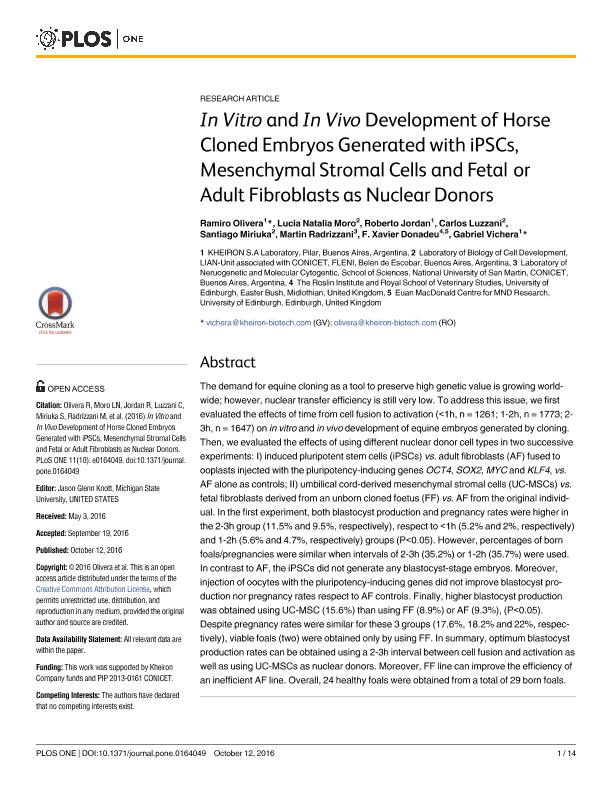Artículo
In Vitro and in vivo development of horse cloned embryos generated with iPSCs, mesenchymal stromal cells and fetal or adult fibroblasts as nuclear donors
Olivera, Ramiro; Moro, Lucía Natalia ; Jordan, Roberto; Luzzani, Carlos Daniel
; Jordan, Roberto; Luzzani, Carlos Daniel ; Miriuka, Santiago Gabriel
; Miriuka, Santiago Gabriel ; Radrizzani Helguera, Martin
; Radrizzani Helguera, Martin ; Xavier Donadeu, F.; Vichera, Gabriel Damian
; Xavier Donadeu, F.; Vichera, Gabriel Damian
 ; Jordan, Roberto; Luzzani, Carlos Daniel
; Jordan, Roberto; Luzzani, Carlos Daniel ; Miriuka, Santiago Gabriel
; Miriuka, Santiago Gabriel ; Radrizzani Helguera, Martin
; Radrizzani Helguera, Martin ; Xavier Donadeu, F.; Vichera, Gabriel Damian
; Xavier Donadeu, F.; Vichera, Gabriel Damian
Fecha de publicación:
10/2016
Editorial:
Public Library of Science
Revista:
Plos One
ISSN:
1932-6203
Idioma:
Inglés
Tipo de recurso:
Artículo publicado
Clasificación temática:
Resumen
The demand for equine cloning as a tool to preserve high genetic value is growing worldwide; however, nuclear transfer efficiency is still very low. To address this issue, we first evaluated the effects of time from cell fusion to activation (<1h, n = 1261; 1-2h, n = 1773; 2-3h, n = 1647) on in vitro and in vivo development of equine embryos generated by cloning. Then, we evaluated the effects of using different nuclear donor cell types in two successive experiments: I) induced pluripotent stem cells (iPSCs) vs. adult fibroblasts (AF) fused to ooplasts injected with the pluripotency-inducing genes OCT4, SOX2, MYC and KLF4, vs. AF alone as controls; II) umbilical cord-derived mesenchymal stromal cells (UC-MSCs) vs. fetal fibroblasts derived from an unborn cloned foetus (FF) vs. AF from the original individual. In the first experiment, both blastocyst production and pregnancy rates were higher in the 2-3h group (11.5% and 9.5%, respectively), respect to <1h (5.2% and 2%, respectively) and 1-2h (5.6% and 4.7%, respectively) groups (P<0.05). However, percentages of born foals/pregnancies were similar when intervals of 2-3h (35.2%) or 1-2h (35.7%) were used. In contrast to AF, the iPSCs did not generate any blastocyst-stage embryos. Moreover, injection of oocytes with the pluripotency-inducing genes did not improve blastocyst production nor pregnancy rates respect to AF controls. Finally, higher blastocyst production was obtained using UC-MSC (15.6%) than using FF (8.9%) or AF (9.3%), (P<0.05). Despite pregnancy rates were similar for these 3 groups (17.6%, 18.2% and 22%, respectively), viable foals (two) were obtained only by using FF. In summary, optimum blastocyst production rates can be obtained using a 2-3h interval between cell fusion and activation as well as using UC-MSCs as nuclear donors. Moreover, FF line can improve the efficiency of an inefficient AF line. Overall, 24 healthy foals were obtained from a total of 29 born foals.
Palabras clave:
Cloning
,
Mesenchymal Stem Cells
,
Ipsc
Archivos asociados
Licencia
Identificadores
Colecciones
Articulos(SEDE CENTRAL)
Articulos de SEDE CENTRAL
Articulos de SEDE CENTRAL
Citación
Olivera, Ramiro; Moro, Lucía Natalia; Jordan, Roberto; Luzzani, Carlos Daniel; Miriuka, Santiago Gabriel; et al.; In Vitro and in vivo development of horse cloned embryos generated with iPSCs, mesenchymal stromal cells and fetal or adult fibroblasts as nuclear donors; Public Library of Science; Plos One; 11; 10; 10-2016; 1-14
Compartir
Altmétricas



